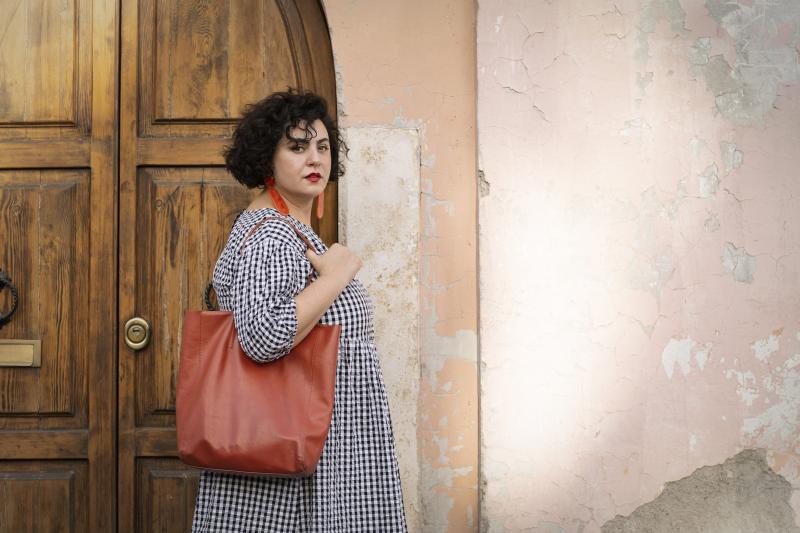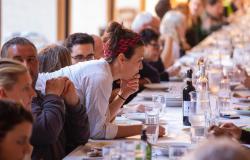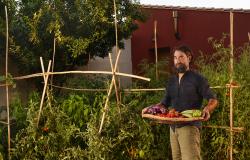It’s spring, and for some 300 million people around the world, that means the arrival of the New Year — Nowruz — a festival that has been celebrated for over three thousand years between the Balkans and the Middle East.
Nowruz usually begins on or around March 21; this year, it kicked off on March 20, but in keeping with Persian panache, the revelry continues for nearly two weeks. Italy Magazine asked me to mark the occasion by spotlighting Saghar Setareh, one of contemporary Italy’s best-known women in food (with the Corriere della Sera creds to prove it), as well as a celebrated food photographer (who Saveur named one of its six favorites in 2017).

Saghar has long been a familiar face in the food-savviest pockets of the web, even as her primary storytelling medium has changed: First there was her blog, Lab Noon, which then gave birth to the requisite Instagram account and, more recently, an intimate, thoughtful Substack newsletter, Noon. But through it all, her long-awaited first book, Pomegranates & Artichokes: A Food Journey From Iran to Italy, has been brewing. Hitting shelves on May 4 (UK/Europe) and June 20 (US/Canada), the book tells, through recipes, the still-unfolding story of making Rome her home via Tehran. Culinary and personal history punctuate Saghar’s thoughtfully developed, alluringly photographed recipes from each of her oft-misunderstood “home” countries — as well as from an in-between realm that somehow embraces and transcends both.
Catching up with Saghar was humbling for me, as a fellow food professional who shares some elements of her Persian heritage (I’m half-Iranian with Sicilian roots, but was born in the US). During my 15-plus-year relationship with Italy, I’ve always been drawn to foods that represent my own cultural contaminazione — blending — of Iran and Italy: finding saffron grown in Tuscany’s San Gimignano, for example, or pistachios from the volcanic soils of Mount Etna’s Bronte, or rose water-accented gelato made in Bolgheri. To my delight, at a community dinner Saghar co-hosted at Tocia in Venice earlier this week, one of the quintessential dishes of the Persian New Year that helps me feel closest to my Iranian family — herbed frittata kuku sabzi — was prepared with wild herbs foraged from Venice’s biodiverse lagoon. (Of course, I still think my aunt makes the best version in the world.)
This interview has been edited for length and clarity.
Sitting down with Saghar Setareh
Coral Sisk: Let’s start with a basic question. How did you end up in Italy?
Saghar Setareh: By chance. I didn’t have any pre-meditations about Italy. I always wanted to live abroad and grew up with the knowledge that this was a possibility, since I had relatives who lived in Europe. People are quick to assume that because I’m from Iran, it was motivated by a need to escape. But at the time, for me, it was more out of personal choice than any sense of urgency.
People all around the world move for personal reasons out of a perception of a better life. Even the people who come on boats are in search of a better life.
There is a sort of fetishism in asking “why did you come to Italy?” Americans aren’t asked this as much because it’s assumed they have the freedom to move around and seek personal improvement. I’ve always felt the pressure that I need to justify myself somehow. This is made much clearer in the intro to the Italy chapter — namely, the idea of why anyone would come to live here if not for marriage.
CS: I get that. I’m an American in Italy myself but I do get this question and people are always confused that I’m not here for marriage or for studies — that I wanted and chose to live here.
What’s your take on what each of your cultures’ culinary traditions does well? What does each do less well? I’d love to hear this in light of how migration has (or hasn’t) influenced Italian and Iranian cultures’ respective cuisines.
SS: Italian food’s revered quality is related to terroir and its good growing climate. But on a larger historical scale, dishes and ingredients have been influenced by everything that has happened — occupations, for example — and this is touched upon in various recipes in the book.
The climate is similar to that of the Middle East, so foods that were brought over naturally flourished. One common thread I find fascinating is that all cultures are based on bread and embrace a culture of saving stale bread. Italian food lovers know panzanella, but in Lebanon and Syria, which were once under Ottoman rule, you have fattoush, these little bowls that look and taste like panzanella.
Just as it was in the Middle East, Italians or people living on this land existed, but Italy wasn’t unified until the end of the 19th century, and the country’s regionality is due to the centuries of foreign influence that modern Italian cuisine fails to acknowledge.

An example is eggplant. Arabs hated it; it wasn’t sweet like it is now. Preparing eggplant involved salting it for hours even as recently as 20 years ago.
Doctors were averse to raw fruits and vegetables, especially eggplant; it was said that its bitter water was poisonous. As time went on, they warmed to it; some Levantine and Middle Eastern poets likened this water, once considered bitter or poisonous, to the saliva of a lover.
When the Arabs conquered Italy and Spain, Italians and Spaniards ended up hating the eggplant, too, for centuries. Jewish people were the only ones who used eggplant and artichokes; all the things that Italians hated were designated for Jews and other marginalized people, or even for dogs. Now these items are beloved. Peppers — brought over from the Americas — were treated as a vulgar food.
CS: It’s fascinating how many Italians aren’t aware of their own culinary history. I see parallels between what you’re saying and the ways that Chinese food tends to be treated with suspicion by many Italians, for example.
SS: Yes. Massimo Montanari, the author of A Short History of Spaghetti With Tomato Sauce and an expert in medieval Italian food history, wrote that it wasn’t until the 20th century that Italians were regularly eating tomato with pasta. [Montanari explains] it was the Jews in Italy who first used these new foods, because the Christians were wary of them. Amusingly, Pellegrino Artusi wrote in his 19th-century classic Science in the Kitchen and the Art of Eating Well that if eggplants were considered vile because Jewish people ate them, it only showed that, “As with other significant things, they have more of a buon naso — a ‘nose for things’ or ‘acumen’ — than Christians.”
Pride in Italy is often projected onto food without really knowing anything of that food’s past or having traveled outside Europe due to a white colonialist mindset.
As for Persian food, Iran is an isolated nation. [You’ll see a divide] in the types of foods that are eaten when dining out versus at home. Women, until 40 years ago or so, were mostly housewives and had the time to make elaborate khoresh stews. It would be odd — it still is odd — to order these kinds of food when out. Like herbed bean and lamb ghormeh sabzi stew, which is one of Iran’s most beloved national comfort dishes. What you see in dining-out culture is mostly grilled kebab, because that was harder to make at home.
Now, because of the tyranny of the Islamic Republic, going out to eat was the only entertainment really allowed, so the dining-out culture and options have shifted over the last 40 years. Young people have been responsible for the rise of fast food and sandwiches as they’re seen at the cool, trendy places.
And to that end, both Iran and Italy have a cucina povera — ‘poor’ or simple food — that has become more [glamorized in restaurant culture]. In Persian culture, for example, you’d never give a guest Eshkene-ye maast, an egg yogurt soup [the recipe for which is in the book]. You’d never find it in restaurants. Now, though, this is becoming common.

Centralism, or the idea that everything is good in the capital, contributes to homogenization of popular cuisine. It sets things up so that everyone [on the outside] is mocked, including ethnic minorities. We can’t uniformly call Iranian food ‘Persian food,’ for example, as ‘Persian’ is just one of Iran's many ethnicities. In the book I put it this way: “The problem with referring to the culture of Iran as Persian (as opposed to Iranian), is that ‘Persians,’ as an ethnicity, are only one of many present in Iran, and only make up half the population. The remaining Iranians belong to other ethnicities, often with their own dialect or language. Referring to the culture of Iran as ‘Persian’ alone is an act of erasure to all those beautiful ethnicities and regional differences.”
Persian restaurants abroad, too, differ wildly from restaurants in Iran, as they are ambiences recreated con fantasia — with imagination, with a certain amount of theatrics and nostalgia — for those who are part of the Iranian diaspora, drawing on all we left behind and our longing for that feeling of home.
CS: Now, about that feeling of home. You have a statement on your website that really jumped out at me: “I am confident in saying that no other experience has marked my life the way immigration has. As a Middle Eastern immigrant, my being is never really from neither Iran, nor Italy. One of these lands lives in me and in the other I live; and yet they are both always with me.” Could you expand on this?
SS: Perhaps being too young and naive when I left, I didn’t realize that when you come to a different country you become an immigrant and you’ll forever be an immigrant — and it’s especially so in Italy, unless you’re American. When you become an immigrant, you become a different person and it is constant. It’s relentlessly omnipresent.
It’s hard to deal with di dove sei? (Where are you from?) being the second or third question I’m always asked, even after 16 years in Italy. I’m so tired of that conversation, and of how every experience is marked by that idea that you’re not from here, as I discuss in my Iran chapter. A quote from Fatimah Asghar’s “On Loneliness” in The Good Immigrant USA opens that chapter: “The question ‘Where are you from?’ has punctured most days of my life, and has been both innocuous and frightening.”
I recently attended a slow food event at an occupato space [in Rome] that houses a huge Afghan community and now also serves as a co-working center. (It’s called Spintime, and the city is trying to clear it out.) I was asked if I was a refugee by Italians who attended. [This kind of thing] is relentless and exhausting. Being an outsider never ends.

CS: Are there any specific dishes that reflect movement of peoples, or your own personal history, that feel particularly profound to you?
SS: As the intro explains, “This is essentially what Pomegranates & Artichokes is about: migrations. Of ingredients, of recipes and of stories — but most importantly, of the people who make them. Of a home that is no longer a solid, fixed space but is now an immense, fluid concept with undefined borders, free to wander and take new shapes, just as the eggplant dish takes different names as the condiments change.”
As for specifics, researching Muhallabia (milky white pudding) and the history of white pudding, including Italian panna cotta or French blancmanage, blew me away. There’s an Arabized word, isfidhabaj, meaning “white stew,” from a Persian term sepidba (sepid meaning white, ba meaning soup). There’s [a parallel] with the Italian biancomangiare. We can’t really prove that one came from the other, but they’re very similar, in that they both use white ingredients — beans, meats, sugar — and no yellow spices, so no turmeric, saffron or cinnamon, for example. There might be chickpeas or almonds. They’re dishes for the frail or the sick. In Turkey, there’s a similar recipe with chicken breast that has the same kind of concept as mangiare in bianco — Italian for, literally, “eating white” [when looking to avoid illness or stomach irritation]. When I was a child and would get sick, I’d be nursed on almond pudding and grated almonds in hot water. And almonds often figured into medieval European blancmange as a precious ingredient from the East.

All the stuffed vegetables were interesting, too, when looking at migration as a theme. Italian rice-stuffed tomatoes, for example, have an uncanny resemblance to Iranian dolmeh. And learning more about how Sephardic Jewish cuisine traveled freely [was really special].
CS: It’s Nowruz. How do you mark the Persian New Year in Italy? How has that experience perhaps been enriched by being in Italy, even if it’s shifted in some ways?
SS: Nowruz is like Christmas to Iranians. It’s when symbols start showing up — goldfish, flowers, herb plants and other items for the Haft Sin table arrangements.
Those items are missing in Italy, so the Iranian community clings closer together during this time in order to best recreate that atmosphere. This year I’m exhausted and don’t feel like celebrating as Iranians are in a collective state of mourning due to the ongoing brutal uprising. That said, it’s vital to keep up the traditions, considering the meaning of Nowruz — literally, New Day — which is the spirit behind the “Woman Life Freedom” uprising spurred on by the loss of Mahsa Amini.
In the past, I reveled in bringing Persian traditions to the creative community in Italy via mehmoonis (parties) and inviting Iranian-Italian friends in to share or expand their connection or feeling of inclusion. But I have a bit more of a guardedness around it now, as sometimes people would treat being included as a sort of novel exhibit, expecting a show of how Persians celebrate.

CS: What was the biggest challenge you faced with the book?
SS: The biggest challenge was just getting it published. I came up with the concept in 2017, but it wasn’t accepted by a publisher until January 2020. I spent years working on the proposal as I didn’t want to do a sort of “five easy Persian recipes” type approach but to do a lot of research and preparation.
I also faced the challenge of some personal health problems (like a broken leg) while moving forward with it. Then there was the 2020 lockdown that started in March, and I was in crutches until November, so there were physical limitations to the research and ingredient shopping I could do, between lockdowns and a broken leg!
But I was happy during the process. The editing was difficult, having to cut things back. But I was involved in all of the design and photography aspects, too, and I’m very grateful for that.
CS: Who is this book for?
SS: This book is for anyone who has curiosities for where these recipes come from, for all of us who’ve encountered immigrants in our life, for all who love vibrant Italian and Iranian or Middle Eastern food. But ultimately it’s for those who enjoy cooking a delicious recipe that speaks to you. While it’s dense with historical context, the beauty of the food itself proves that Iranian culture doesn’t have to be all tragic.
Where to connect with Saghar and her work


















